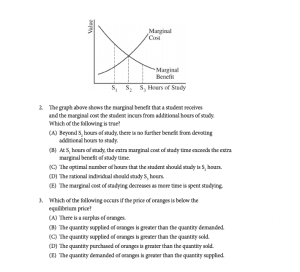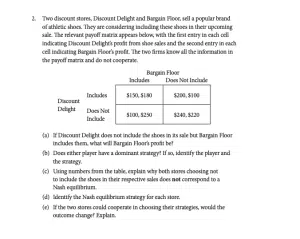The Ultimate Guide to Acing the AP Microeconomics Exam
For high school students who are committed to excellence and looking to earn a spot at one of the nation’s most prestigious universities, a great way to get a head start on that journey is to enroll in AP courses and take AP exams such as the AP Microeconomics Exam.
When it comes to taking AP courses such as the AP Macroeconomics Exam, there are a lot of aspects of the exam itself that can help high school students prepare for succeeding at getting the score they desire. Hear at AdmissionSight, we make it our number one priority to help high schoolers achieve their most advantageous goals. Chances are good those goals will be helped by enrolling in several AP courses.
But before we go over how to score a perfect 5 out of 5 on the AP Microeconomics Exam, Let’s go over why taking AP courses and exams is a good idea for high school students.
Help you prepare for college
One of the most essential reasons why high school students should think about taking AP courses is because they can help those students prepare for what is to come in college. The College Board has created the curriculum of AP courses to replicate introductory college classes.
AP courses are fast-paced, cover lots of material, and tend to require quite a bit more out-of-classwork such as research and critical thinking, as the regular high school classes do. For students looking to Excel not only in high school but also in college, AP courses are a great way to know what to expect.
Students get to study what they love
One great reason why students should consider taking AP courses is that they allow students to dive deeply into subjects that they are passionate about and love. When it comes to the AP Microeconomics Exam, students who are excited by mathematics or interested in possibly pursuing a business career will be ecstatic about the information they are given and the problems that they are expected to solve in this class. Whether you are interested in STEM subjects, English and literature, history, or learning new languages, there is an AP course that will allow you to push yourself in the classroom.
Earn some college credits
Another reason many students want to take AP courses in high school is that they offer students the opportunity to earn college credit and placement. Every AP exam is graded on a five-point scale. A 5 out of 5 is the best score a student can earn, while 1 out of 5 is the worst. In many cases, students earning at least a 3 out 5 can earn some form of college credit or placement. In fact, in some cases, high school students can test out of introductory college courses altogether.
Look great in the eyes of college admissions officers
One of the best reasons to consider taking an AP course is that college admissions officers will take notice of the difficulty of the classes a student takes in high school. Enrolling in AP courses shows these university admission officers that high school student is ready for the hard work they will face once they arrive at college. Not only that but voluntarily enrolling in AP courses proves to those who look at your transcript that you are willing to go the extra mile and work even harder to achieve your goals and gain the education that you want for yourself.
Improve your transcript
everybody knows that a strong GPA is an essential aspect of getting into the college or university of your dreams. When it comes to taking AP classes, you may enjoy the benefits of extra weight being attributed to the grade that you receive in the course. That means a B grade could show up as an A on your transcript. Or an A- could show up as an A+. Now, how’s that for making the most out of your curriculum?
What is the AP Microeconomics exam?
The AP Microeconomics Course is a college-level course that introduces students to the basic principles of economics that specifically apply to the functions of individual economic decisions and decision-makers. The course also sets out to develop a student’s familiarity with the operation of product and factor markets, distributions of income, the role of government in promoting greater efficiency and equity in an economy, and market failure. On top of learning essential facts and information, students will also learn how to use information that comes in graphs, charts, and data to analyze, describe, and explain greater economic concepts.
There are no official prerequisites for this course and exam, students are encouraged to enroll in the course as long as they possess basic math and graphing skills.
This is the case with all other AP courses, the AP Microeconomics. course set out to help teach students a clear list of skills that will help them succeed in this course and beyond. those core skills are listed below:
| Skill | Description |
| 1. Principles and Models | Define economic principles and models. |
| 2. Interpretation | Explain given economic outcomes. |
| 3. Manipulation | Determine outcomes of specific economic situations. |
| 4. Graphing and Visuals | Model economic situations using graphs or visual representations. |
Along with the course skills, the AP Microeconomics course also comes with its own list of big ideas. Big ideas are a part of every AP course and serve as the foundation of the course which allows the students enrolled to create meaningful connections from concept to concept. Often, these big ideas are abstract concepts or themes that become threads within the course and help link one idea or unit to the next.
Students who can utilize these big ideas and apply them in a variety of contexts will have a greater understanding of the material as well as a greater chance of success in the exam. the big ideas for this AP course are below:
- Scarcity and Markets: This idea revolves around the fundamental concept of scarcity and its influence on resource allocation and market decision-making.
- Costs, Benefits, and Marginal Analysis: This concept involves understanding the costs and benefits of decisions and using marginal analysis to make rational choices.
- Product Markets and Efficiency: This idea encompasses the nature and functions of product markets, efficiency, equity, and the role of government in promoting greater efficiency and equity in the economy.
- Market Inefficiency and Public Policy: This concept focuses on market inefficiency and the potential role of public policy in addressing market failures.
These big ideas form the foundational concepts students explore in AP Microeconomics, providing a comprehensive understanding of microeconomic principles and their real-world applications.
The final thing to know about how this course works is that it is broken into six units. These units are weighted differently on the AP Microeconomics Exam, with the range of percentage in weight shown below:
| Unit | Exam Weighting (Multiple-Choice Section) |
| Unit 1: Basic Economic Concepts | 12%–15% |
| Unit 2: Supply and Demand | 20%–25% |
| Unit 3: Production, Cost, and the Perfect Competition Model | 22%–25% |
| Unit 4: Imperfect Competition | 15%–22% |
| Unit 5: Factor Markets | 10%–13% |
| Unit 6: Market Failure and the Role of Government | 8%–13% |
Why is the AP Microeconomics Exam important?
The AP Microeconomics Exam is a valuable stepping stone for high school students pursuing degrees in economics, business, or related fields in college. By performing well in this exam, you demonstrate your proficiency in microeconomic concepts, thus enhancing your college applications and potentially earning college credit.
Beyond college admissions, the knowledge and analytical skills gained through preparing for and taking the AP Microeconomics Exam can benefit students in various career paths. Whether you plan to become an economist, investment banker, entrepreneur, or policymaker, a strong foundation in microeconomics is essential.
Microeconomics, a branch of economics that focuses on individual decision-making and the behavior of firms, plays a crucial role in understanding how markets function and how resources are allocated. By studying microeconomics, students gain insights into the forces that shape supply and demand, the determination of prices, and the efficiency of resource allocation.
One of the key benefits of taking the AP Microeconomics Exam is the opportunity to develop critical thinking and problem-solving skills. The exam requires students to analyze real-world scenarios and apply economic principles to solve complex problems. This process of analyzing and evaluating different options helps students develop a logical and systematic approach to decision-making, a skill that is highly valued in both academic and professional settings.
Moreover, the AP Microeconomics Exam gives students a comprehensive understanding of market structures. From perfect competition to monopoly, students learn about the different types of markets and the implications of market structures on pricing, output, and efficiency. This knowledge is invaluable for aspiring entrepreneurs and business leaders who must navigate the competitive landscape and make informed strategic decisions.
Additionally, the AP Microeconomics Exam covers topics such as consumer behavior, production and cost analysis, and market failure. These concepts equip students with a deeper understanding of the factors that influence consumer choices, the production decisions of firms, and the role of government intervention in correcting market failures. Such knowledge is essential for individuals interested in pursuing careers in public policy, where they can contribute to designing effective economic policies and addressing societal challenges.
By taking the AP Microeconomics Exam, students also develop strong quantitative skills. Microeconomics involves analyzing data, interpreting graphs and charts, and using mathematical models to understand economic relationships. These skills are highly transferable and can be applied in various fields, including finance, data analysis, and research.
Overall, the AP Microeconomics Exam is crucial because it not only prepares students for further studies in economics but also equips them with valuable skills and knowledge that are applicable in a wide range of careers. Whether you aspire to be an economist shaping economic policies or an entrepreneur starting your own business, a solid foundation in microeconomics will undoubtedly set you on the path to success.
How long is the AP Microeconomics Exam?
The AP Microeconomics exam is 2 hours and 10 minutes long. It consists of 60 multiple-choice questions and 3 free-response questions. The multiple-choice section lasts for 1 hour and 10 minutes and is worth 66% of the total exam score, while the free-response section lasts for 1 hour and is worth 33% of the total exam score.
How hard is the AP Microeconomics Exam?
The difficulty of the AP Microeconomics exam is subjective and can vary depending on individual students’ familiarity with economic concepts and their ability to work with data. According to data from the College Board, the pass rate for the AP Microeconomics exam is slightly lower than the average pass rate across all AP exams, with around 60% of students scoring a three or higher.
The exam is designed to mimic an introductory college-level course, so students unfamiliar with economic topics or data analysis may find it challenging. However, the course covers fewer units of study than some other AP classes and explores a narrower topic, which may make it more manageable for some students. Additionally, the pass rate for the exam is around 57%, and it is considered relatively easy compared to other AP classes, with a difficulty rating of 4.4/10.
Ultimately, the difficulty of the AP Microeconomics exam is influenced by students’ prior knowledge, study habits, and interest in the subject matter. While some students may find it challenging, others may perceive it as more manageable. It is essential for students to consider their strengths and interests when deciding whether to take the AP Microeconomics course and exam.
What factors affect the difficulty of the AP Microeconomics Exam?
Several factors can affect the difficulty of the AP Microeconomics exam. These factors include:
- Prior Knowledge: Students who have prior knowledge of economic concepts and principles may find the exam more manageable than those who are new to the subject.
- Test-Taking Skills: Students with strong test-taking skills, such as time management, process of elimination, and critical thinking, may perform better on the exam.
- Preparation: Students who prepare adequately for the exam, such as by studying the course material, practicing with past exams, and seeking help, may find the exam easier.
- Exam Format: The exam format, including the number of questions, the types of questions, and the time limit, can affect the difficulty of the exam.
- Subjective Difficulty: The difficulty of the exam is subjective and can vary depending on individual students’ familiarity with economic concepts and their ability to work with data.
Overall, the difficulty of the AP Microeconomics exam is influenced by a combination of factors, including prior knowledge, test-taking skills, preparation, exam format, and subjective difficulty. Students can improve their chances of success by preparing adequately, practicing with past exams, and seeking help when needed
AP Microeconomics Exam Format
When it comes to the AP Microeconomics Exam, has one of the highest success rates among students who take it. That is, of course, if your idea of success is scoring a perfect 5 out 5.
When it comes to the exam format, it is not only one of the easiest from a statistical standpoint, with well over 50 percent of those who take it scoring either a 4 or a 5, it is also one of the shortest.
Multiple-choice
The first section of the exam is a multiple-choice section that takes the first hour and 10 minutes of the total allotted time and is made up of 60 total questions. In all, the multiple-choice section of the exam is worth 66 percent of the total score of the exam.
The multiple-choice Section of the AP Microeconomics Exam tests your knowledge and understanding of microeconomic concepts. It consists of 60 questions, each with four answer choices. These questions cover various topics, including supply and demand, market structures, consumer behavior, and production costs. To excel in this section, it is essential to have a solid grasp of these fundamental concepts and their applications in real-world scenarios.
As you navigate through the multiple-choice Section, you will encounter various questions. Some questions may require you to analyze graphs and interpret data, while others may ask you to apply economic principles to solve problems. It is essential to carefully read each question and consider all the answer choices before selecting the most appropriate one.
A few samples of types of multiple-choice questions that students can expect on the exam include the following:
Tackling the multiple-choice section
To tackle the multiple-choice section of the AP Microeconomics exam, students can follow these tips:
- Understand the format: The multiple-choice section consists of 60 questions lasting 1 hour and 10 minutes. It is worth 66% of the total exam score.
- Practice with past exams: The College Board provides past exams that students can use to practice and familiarize themselves with the questions that may appear on the exam.
- Identify unfamiliar concepts: Students should identify unfamiliar concepts and topics and focus on studying them to improve their understanding.
- Use the process of elimination: Students can use the process of elimination to eliminate incorrect answers and increase their chances of selecting the correct answer.
- Read the question carefully: Students should read each question carefully and pay attention to details such as units of measurement and keywords.
- Answer every question: There is no penalty for guessing, so students should answer every question, even if they are unsure of the answer.
- Manage time effectively: Students should manage their time and pace themselves to ensure they have enough time to answer all the questions.
By following these tips, students can improve their chances of success on the multiple-choice section of the AP Microeconomics exam.
Free Response
Once you have completed the Multiple-Choice Section, you will move on to the Free-Response Section of the exam.
The free-response section of the AP Microeconomics exam consists of three questions, one of which is a longer question worth 50% of the section score, and the other two are shorter questions, each worth 25% of the section score. Students must answer these questions with withdrawn graphics, and the section is worth about 33% of the overall exam score. The section includes a 10-minute recommended planning time followed by 50 minutes of writing, for one hour. Students are expected to demonstrate their understanding of specific economic theory and their ability to apply it.
Clear and concise labeling of answers and graphs, as well as complete and concise sentences, are essential for effectively addressing each part of the questions within the limited time frame. Students are encouraged to practice with past free-response questions to become familiar with the format and refine their test-taking abilities
Several sample questions that are similar to the ones that you might face on the AP Microeconomics Exam are below:
As you now know, your chances of success regarding this exam from a statistical standpoint are actually in your favor! With that being said, just because over half of people who took the exam scored a 4 or 5 last year, does not mean that you are automatically going to be a part of that group when you take the exam yourself.
Tackling the free-response section
To tackle the free-response section of the AP Microeconomics exam, students can employ the following strategies:
- Practice Free Response Questions: Engage in a regular practice of free-response questions to become familiar with the types of questions and the expected answers. This will help in understanding the format and refining test-taking abilities.
- Understand the Question Format: The free-response section consists of one longer question worth 50% of the section score and two shorter questions, each worth 25%. It is essential to understand the specific requirements of each question and allocate time accordingly.
- Master Graphs and Labeling: Ensure a firm grasp of drawing and labeling graphs, as they are often required in the free-response section. Precise and accurate labeling is crucial for conveying understanding and earning points.
- Concise and Complete Responses: Given the limited time for completing the free-response section, it is essential to write in complete, concise sentences. Avoid lengthy introductions and focus on clearly labeling and answering each part of the question.
- Time Management: Allocate time effectively for each question, considering the weightage of each question. Planning and managing time well can help ensure that all questions are addressed within the time limit.
By following these strategies, students can enhance their preparedness and approach to the free-response section of the AP Microeconomics exam, ultimately improving their performance and scores
What is on the AP Music Theory Exam?
The AP Microeconomics Exam covers various topics essential to understanding the fundamental principles of microeconomics. Here are the main topics you can expect to encounter during the exam:
- Scarcity, Choice, and Opportunity Cost
- Supply and Demand
- Market Structures
- Firm Behavior and Market Efficiency
- Factor Markets
- Market Failure and the Role of Government
Let’s dive deeper into each of these topics:
1. Scarcity, Choice, and Opportunity Cost:
In microeconomics, scarcity refers to the limited availability of resources to satisfy unlimited wants and needs. This concept is crucial in understanding how individuals, firms, and societies choose. The AP Microeconomics Exam will test your understanding of how scarcity forces individuals and firms to make choices and the concept of opportunity cost, which is the value of the next best alternative foregone when making a decision.
2. Supply and Demand:
Supply and demand are the fundamental forces that drive market economies. The exam will assess your knowledge of how supply and demand interact to determine equilibrium prices and quantities in different market scenarios. You will need to understand concepts such as price elasticity of demand and supply, market equilibrium, and the factors that influence shifts in supply and demand curves.
3. Market Structures:
Market structures refer to the different types of market organizations and their characteristics. The exam will cover the four main market structures: perfect competition, monopolistic competition, oligopoly, and monopoly. You will need to understand the characteristics of each market structure, including the number of firms, barriers to entry, and the impact on price and output decisions.
4. Firm Behavior and Market Efficiency:
This topic focuses on the behavior of firms and their decision-making processes. You must understand profit maximization, cost analysis, revenue analysis, and the relationship between production costs and output levels. Additionally, the exam will test your knowledge of market efficiency, including concepts such as productive efficiency and allocative efficiency.
5. Factor Markets:
Factor markets are markets where factors of production, such as labor and capital, are bought and sold. The exam will assess your understanding of how factor markets operate, including determining wages, interest rates, and rent. You will also need to understand the concept of marginal productivity and its impact on factor pricing.
6. Market Failure and the Role of Government:
Market failure occurs when the market mechanism fails to allocate resources efficiently. This topic explores the reasons for market failure and the role of government in addressing these failures. You will need to understand concepts such as externalities, public goods, and the different types of government intervention, including regulation and taxation.
By thoroughly studying and understanding these topics, you will be well-prepared for the AP Microeconomics Exam. Remember to practice applying these concepts to real-world scenarios and to review past exam questions to familiarize yourself with the exam format. Now that we have a clear understanding of the exam structure and scoring,
AP Microeconomics Exam Scoring Breakdown
Now that you’re familiar with what to expect on the AP Microeconomics Exam, let’s explore how the exam is scored:
The multiple-choice section accounts for 66.7% of your total score, while the free-response section accounts for 33.3%. Each section is scored on a scale of 1 to 5, with 5 being the highest score.
Regarding the multiple-choice section, you will be presented with questions that test your understanding of microeconomic concepts. These questions will cover topics such as supply and demand, market equilibrium, consumer behavior, and the role of government in the economy. It is essential to carefully read each question and consider all possible answer choices before selecting. Remember, there is only one correct answer for each question, so choose wisely.
The free-response section, on the other hand, requires you to demonstrate your ability to apply economic principles to real-world scenarios. You will be presented with a series of prompts that ask you to analyze economic situations, solve problems, and provide written explanations of your reasoning. This section allows you to showcase your understanding of microeconomic concepts in a more in-depth and analytical manner. It is crucial to communicate your thoughts and use appropriate economic terminology to support your arguments.
Scoring for both sections is done by trained AP exam readers who follow a specific rubric provided by the College Board. These readers are experienced economics educators who have a deep understanding of the subject matter and the scoring guidelines. They carefully evaluate each response and assign a score based on the quality of the analysis, the accuracy of the information provided, and the clarity of the writing.
After all the multiple-choice and free-response sections have been scored, the scores are combined to determine your overall AP Microeconomics Exam score. The scale ranges from 1 to 5, with 5 being the highest score. A score of 3 or higher is considered passing and may earn you college credit or advanced placement in microeconomics courses.
But how can you effectively study for such a comprehensive test? Here at AdmissionSight, we believe preparation is the best way to lead to success. For that reason, we have broken down the several steps that you should take to ensure the most significant level of success once the day of the exam finally comes.
How to study for the AP Microeconomics Exam
Assess your knowledge and ability
The first step that you will want to take when it comes to preparing for the AP Microeconomics Exam is to take a full practice exam. This is not only an ability to dip your toes into the exam format, but it is also an excellent way for you to assess your knowledge. While you do not have to time yourself in the way that you will be timed on the actual exam day (feel free to do so if you want), you will have to cross-reference the answers that you come up with to the answers that are offered in the resource that you are utilizing.
One of the best resources for this step is an exam from the past year. A few of the exams that you could take are here and here.
The reason why you want to cross-check your answers with the answers that are offered in the key is for two reasons. First off, it can serve as a fantastic learning opportunity for you to see what you may have gotten wrong. More importantly, it is an opportunity for you to identify any trends regarding which types of questions you were repeatedly getting wrong.
Master the theory
When it comes to the AP Microeconomics Exam, mastering the basic economic principles that you will be taught in the class along with specific microeconomic vocabulary and theory is paramount to scoring that perfect 5 out of 5. Overall this includes the following subjects:
- Basic economic theory
- Nature and functions of product markets
- Factor markets
- Market failure and the government’s role
Along with the course itself. There are several fantastic online and in-print resources that you can take advantage of as you seek to understand these fascinating concepts fully. Other great options for students who are looking to master these theories are to work with the teacher who taught the course out of class or seek to create a study group made up of their fellow classmates and friends so that they can quiz one another, discuss the topics, and grade each other’s question sets and practice exams, which takes us to the next step of preparing for the exam.
Practice multiple-choice and free-response questions
Once you have mastered these concepts, it is time to focus on mastering the many different forms in which you will be tested. This means putting an emphasis on practicing as many sets of questions as possible – both multiple-choice questions and free-response questions – to try to ensure that no matter what you see on the day of the actual exam, you will have a certain amount of confidence that you know what the question is asking.
Much like the ACT or SAT exams, AP exams are as much about mastering the subject matter as it is about mastering the exam itself. That brings us to the final step of preparation.
Take full and timed practice exams
The final thing that you will want to focus your attention on as the day of the exam approaches is the exam itself, or at least practice exams. When taking complete practice exams offered in study guides or using exams from past years, you will want to take as many of these as possible. On top of that, you will want to make sure that you are giving yourself the amount of time that you will have on the day of the actual exam. That way, you can be sure that you won’t be surprised by the speed at which the AP Microeconomics Exam will start and finish.
Tips on the day of the exam
As the exam day approaches, it’s normal to feel nervous and excited. Here are some tips to help you perform your best on the day of the AP Microeconomics Exam:
- Get a Good Night’s Sleep: Ensure you get enough rest the night before the exam to be mentally alert and focused during the test.
- Eat a Healthy Breakfast: Fuel your brain with a balanced breakfast with protein, whole grains, and fruits to maintain energy levels throughout the exam.
- Arrive Early: Plan your route to the exam center and aim to arrive early to avoid any last-minute stress or delays.
- Read Carefully: Take your time to carefully read and understand each question before answering. Pay attention to keywords and specific instructions.
- Manage Your Time: Allocate your time wisely for each exam section. If you encounter a challenging question, move on and return to it later.
- Stay Calm and Focused: Remember to stay calm and focused throughout the exam. Take deep breaths if you feel anxious and trust in your preparation.
When is the AP Microeconomics Exam in 2024?
The specific date for the AP Microeconomics Exam is on Tuesday, May 7th. Students should verify the exact start/report time with their school, as testing times may vary.
For a complete list of the 2024 AP Exam dates, here’s a full list:
| Week 1 | Morning 8 a.m.
Local Time |
Afternoon 12 p.m.
Local Time |
| Monday,
May 6, 2024 |
United States Government and Politics | Art History
Chemistry |
| Tuesday,
May 7, 2024 |
Human Geography
Microeconomics |
Seminar
Statistics |
| Wednesday,
May 8, 2024 |
English Literature and Composition | Comparative Government and Politics
Computer Science A |
| Thursday,
May 9, 2024 |
Chinese Language and Culture
Environmental Science |
Psychology |
| Friday,
May 10, 2024 |
European History
United States History |
Macroeconomics
Spanish Literature and Culture |
| Art and Design: Friday, May 10, 2024 (8 p.m. ET), is the deadline for AP Art and Design students to submit their three portfolio components as final in the AP Digital Portfolio. | ||
| Week 2 | Morning 8 a.m.
Local Time |
Afternoon 12 p.m.
Local Time |
Afternoon 2 p.m.
Local Time |
| Monday,
May 13, 2024 |
Calculus AB
Calculus BC |
Italian Language and Culture
Precalculus |
|
| Tuesday,
May 14, 2024 |
English Language and Composition | African American Studies
Physics C: Mechanics |
Physics C: Electricity and Magnetism |
| Wednesday,
May 15, 2024 |
French Language and Culture
World History: Modern |
Computer Science Principles
Music Theory |
|
| Thursday,
May 16, 2024 |
Spanish Language and Culture | Biology
Japanese Language and Culture |
|
| Friday,
May 17, 2024 |
German Language and Culture
Physics 1: Algebra-Based |
Latin
Physics 2: Algebra-Based |
When do AP scores come out?
AP scores are typically released in early to mid-July of the year the exams were taken. The exact release date may vary slightly from year to year, but students who took their AP exams in May can generally expect their scores to become available.
You can check for updates on the College Board’s official AP scores website if you are waiting for your AP scores. They will also email you when your scores are added to your score report. If you haven’t received your scores by mid-August, contacting AP Services for Students is recommended for assistance.
Post-exam tips
After completing the AP Microeconomics Exam, it’s essential to take some time to reflect on your performance and take note of any areas for improvement. Here are some post-exam tips:
- Evaluate Your Performance: Reflect on your performance and identify areas where you excelled and areas that need improvement. This analysis will guide your future study strategies.
- Review Mistakes: Take the time to review your mistakes and understand where you went wrong. This will help you avoid similar errors in the future.
- Celebrate Your Success: Regardless of your score, celebrate the effort and dedication you invested in your preparation. Every step of the journey counts!
- Seek Feedback: If possible, discuss your performance with your teacher or a knowledgeable mentor who can provide valuable insights and guidance for further improvement.
- Continued Learning: Microeconomics is a dynamic field, so continue to cultivate your interest and deepen your knowledge beyond the scope of the exam. Attend lectures or participate in economic forums to stay informed and engaged.
Conclusion
As this comprehensive guide concludes, you now have all the tools and insights to ace the AP Microeconomics Exam. By understanding the format, topics, and scoring breakdown of the exam, implementing effective study strategies, and applying exam day tips, you are well on your way to success. Remember, preparation is vital, and with diligent effort and focused dedication, you can confidently navigate the world of microeconomics and achieve your academic goals. Good luck!
AdmissionSight is here for you.
If you’re preparing for college but are struggling with the admission process, the AdmissionSight team is here to help. We’ve helped students from across the country find their way into some of the best schools – including the most respected Ivy League Universities. After decades of practical experience, we’ve mastered the admission process. Whether you need help editing supplemental essays, choosing a summer program, or taking your AP exams, we have the expertise to help you succeed.
We’re only happy when our students can achieve their academic goals, so you can count on us to do everything in our power to help you succeed. Feel free to contact us today to learn more about our services, our success stories, and how we can help you on your path toward academic success.














































